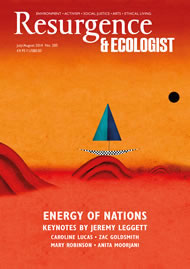To make the world a better place, we have to first envision it as such. Charles Eisenstein is a brave man and impassioned enough to serve that vision of, as he describes it, the more beautiful world our hearts know is possible.
The depth of his vision, the fluency and colour with which he paints it is a gift: it gives us permission to honour what we as humans intuit deep down, beneath the layers of doubt, cynicism or despair – our fundamental interconnectedness.
The book is divided into 36 chapters with compelling one-word headings: Interbeing, Morphogenesis, Spirit, Pleasure, Judgment, Truth and Evil rub shoulders with Climate, Pain, Urgency, Doing, Nondoing, Despair, Science, Insanity, and so on. It’s an impressive spectrum and it says much about Eisenstein’s intellectual scope – he is Yale educated and holds a degree in Mathematics and Philosophy – and yet underlying each essay is an appealing humanity. There is a heartfelt – not dry – questioning of assumptions. There is investigation; there is storytelling, an invitation to view the world and ourselves through an alternative light. It is, in short, a book to stir heart and mind.
Never more so than when Eisenstein shares his own uncertainties, for his is not an unwavering vision. In one of the early chapters, entitled Breakdown, he says: “I wish I could tell you that I am ready for a new Story of the People, but even though I am among its many weavers, I cannot yet fully inhabit the new vestments. As I describe the world that could be, something inside me doubts and rejects, and underneath the doubt is a hurting... The breakdown of the old story is kind of a healing process that uncovers the old wounds hidden under its fabric and exposes them to the healing light of awareness.”
This is also a book about the need to name and embrace our shadows; to recognise with compassion our reactivity and penchant for judgement and projection, all of which creates unnecessary clutter that slows down our (still inevitable) progress towards this more beautiful world.
As Eisenstein suggests, if the prospect of a more beautiful world arouses cynicism, impatience or despair, those feelings aren’t to be pushed aside but acknowledged: “They are gateways to our fully inhabiting a new story, and the vastly expanded power to serve change that it brings.”
He urges us to value the small, positive actions that we take, our small acts of courage and kindness, and recognise the impact they have: “One of the ways that your project, your personal healing, or your social invention can change the world is through story. But even if no one ever learns of it, even if it is invisible to every human on Earth, it will have no less of an effect”.
So the woman who cares quietly, tirelessly for an elderly parent; the community leader who perseveres in a gang zone; or the person who experiences profound healing from abuse is doing the world as a great a service as the visionary leader hailed and admired by all.
Ultimately, The More Beautiful World Our Hearts Know Is Possible empowers us to take the first steps to trust in this vision, resonate with it, have conversations around it, seed more nurturing, wise thinking and being, create a larger narrative – and in so doing, collectively move towards making a more beautiful world a reality.
As Eisenstein says: “We do not have a new story yet. Each of us is aware of some of its threads, for example in most of the things we call alternative, holistic, or ecological today. Here and there we see patterns, designs, emerging parts of the fabric. But the new mythos has not yet formed. We will abide for a time in the ‘space between stories.’ It is a very precious – some might say sacred – time.”
What a gift it is to be reminded of that.







